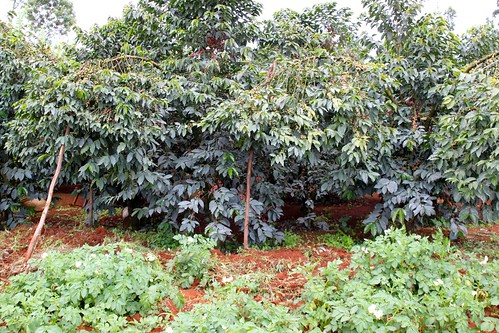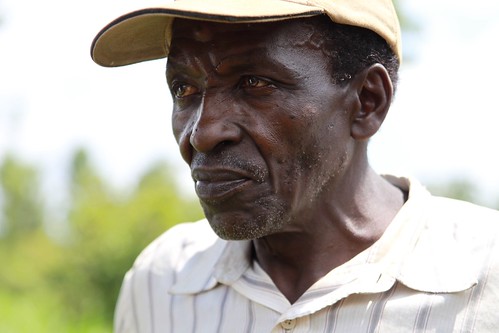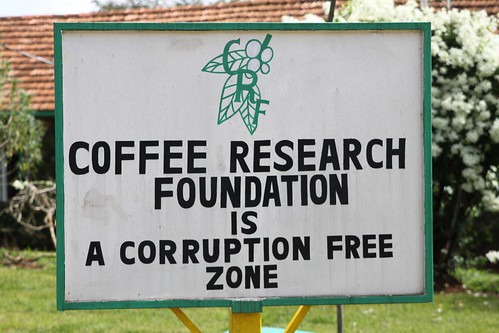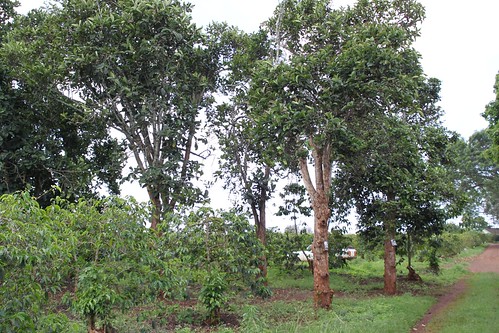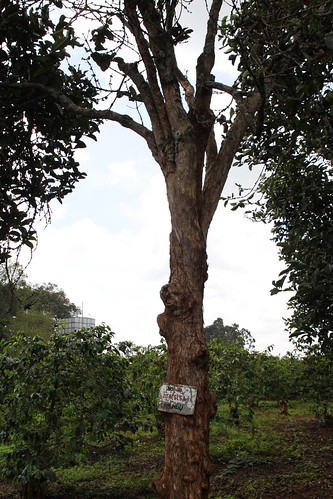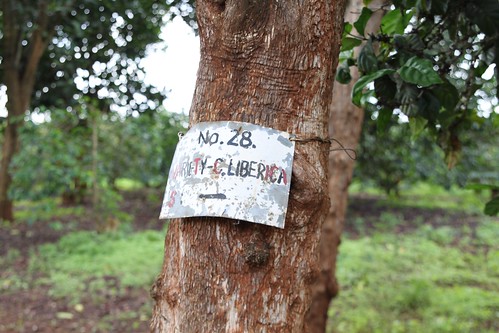As promised here are some more notes from our trip to Kenya last week.
After spending a whole day at the Tekangu coop, filming their processing techniques (to be launched in video soon) and handing over the drying tables we funded through our Drying table project, we went to visit some smallholder farmers to document the picking of the cherries. We visited one shamba (smallholder farm) which was by far the best one I have ever seen.
The trees looked super healthy and the farmer Mr. Eliud Kimotho delivers his coffee to the Karogoto factory. (No wonder their coffee is so tasty.)
He produces an average of 30 kg of coffee cherries per tree and had a total of 180 trees only.
Eliud started farming 10 years ago when he retired from his old work and he also grew corn, potatoes, bananas, grass for his cattle, all mainly for domestic consumption.
We were promised a bag of Mr. Eliud’s coffee to be dried on on the new drying tables at Karogoto and hopefully they will keep their word so I can taste that coffee in February.
On another Shamba we visited in Kirinyaga, the trees looked a lot more stressed, had more leaf rust and were carrying very little cherries.
This was because the farmer did not have money to buy fertilizer and copper spray as the cooperative he was a part of were not able to pre-finance his farm input. The problem with this is that in Kenya most farmers get pre-financing for farm input (fertilizer, etc) based upon the last crop yields. Since the crop yield is very low this year, the farmers will not be able to buy enough fertilizer, etc for the 2011/12 crop -the prognosis is that it will be very high in volume. That means the farmers will not be able to produce to the full potential in 2011. It is easy to forget what long term effects a bad crop can have on a farmer. As a coffee buyer we are only affected by the fluctuations in the prices and that is why I believe it is important to support the farmers also when the prices or yields are low by paying more for their best qualities.
Thursday morning we also cupped different grades.
This means we took samples from the same lot but sorted the beans in the different sizes as they are sold on auction. (AA / AB / PB / C / T / TT and UG). The results were fairly obvious, the AA was the best (biggest beans) The PB (Peaberry) and AB were fairly similar and C, T, and TT were bitter and flat and some had sour and fermenty taste. The UG (Ungraded) was by far the worst coffee I have ever tasted. It tasted like manure and rotten fruit. The aromas was similar to the ones you get when you are standing in a barn full of cows and sheep. What is shocking about these coffees is that they are actually sold.
On friday morning we drove from Nyeri to Ruiru to visit the Coffee Research Foundation.
We had just heard that they had released a new coffee varietal, called Batian (The name of the peak of Mt. Kenya,) that they spent 12 years developing. Batian is a new alternative to the not so tasty Ruiru 11 that the Research Foundation had developed in the 80’s. Both varietals are more resistant to Coffee Berry Disiease and Leaf Rust than the traditional varietals grown in Kenya, SL 28 and SL 34. The problem is that the best coffees from Kenya are normally coming from the SL varietals, so we were interested to taste the new Batian variety next to the Ruiru 11 and the SL 28 and SL 34.
When we arrived we got a tour of the CRF and also a presentation of what work they are doing there. Basically, it is a resource center for coffee in Kenya where they train farmers, analyze soil and fertilizers, develop new varietals and research and develop new agricultural practices.
The greatest part of the tour was their varietal museum. Here we got to see some amazing coffee trees, and their Coffea Ecxelsa and Liberica trees were the biggest coffee trees I have ever seen.(See biggest trees in pictures below)
They also had a lot of other varietals in their museum plot, but you can see more of them in the slide show on the bottom of this page.
After the tour we headed in to the CRF cupping lab to taste coffee. We were presented with 4 unnamed samples that we cupped before the coffees were revealed as Batian, SL 28, Ruiru 11 and a cup with a blend of Ruiru 11 and SL 28.
It turned out that I actually liket the Batian varietal the best. It was by far the sweetest and most floral and fruity. My second favourite was the blend and my 3rd favourite was the SL28. This was an unusual result but not too surprising as we were already were sceptical of the setup of the cupping. To be honest, all the coffees were very dark roasted and roasted on the same day as the cupping. The SL28 was not a good SL 28; it was both baggy and from the west part of Kenya which traditionally does not grow the best coffees. In fact all the coffees were grown in different parts of the country, so we suspected the CFR guys to set up a cupping to favour the Batian varietal as they have spent 12 years developing it. The only thing that did not surprise me with the cuping was that the Ruiru 11 was the worst coffee. This was flat and woody and very bitter.
I asked to get some samples of the Batian coffee to take home so I could cup it next to our SL28/34 from Tekangu and Mugaga, but our tour guide at CRF would not let me have it.
Regardless of that, I am very much looking forward to tasting the Batian varietal in the future as it seemed that a lot of farmers were already implementing the new plant in their fields. Hopefully it will not compromise the quality of Kenyan coffee in the future.
I will be going back to Kenya in February to buy and taste the coffees that is picked right now. More on that next year.


